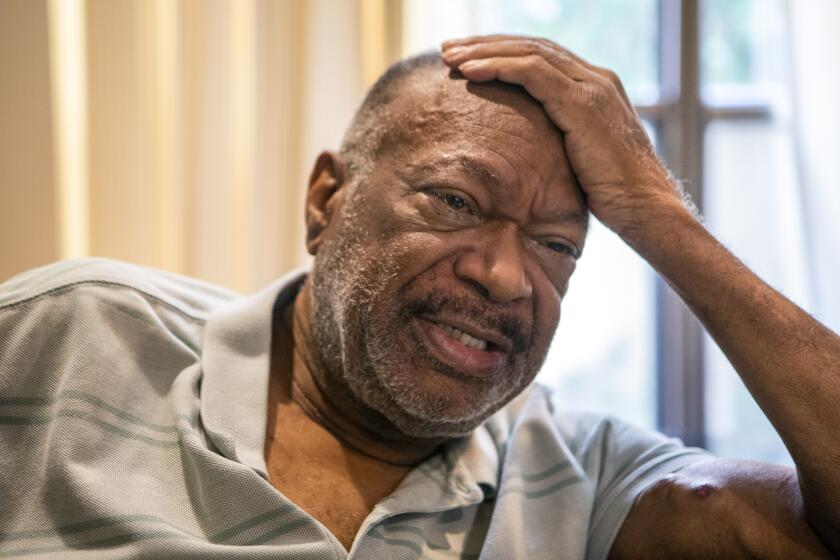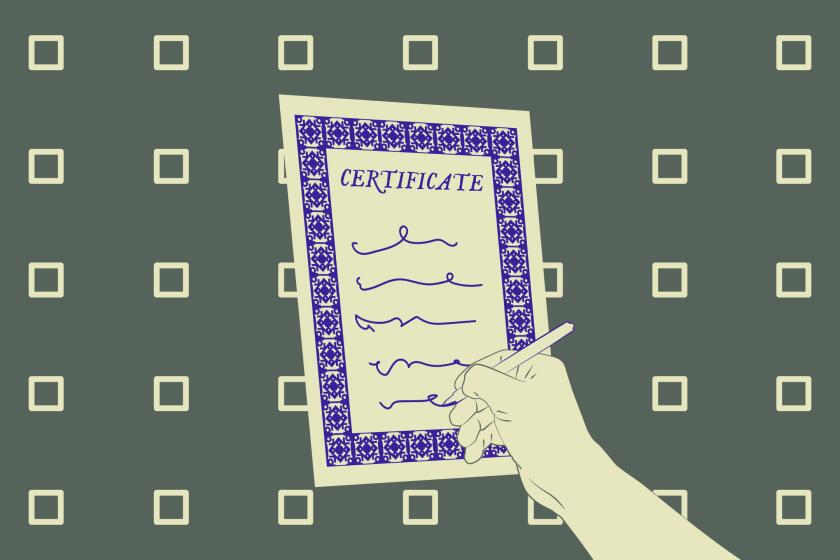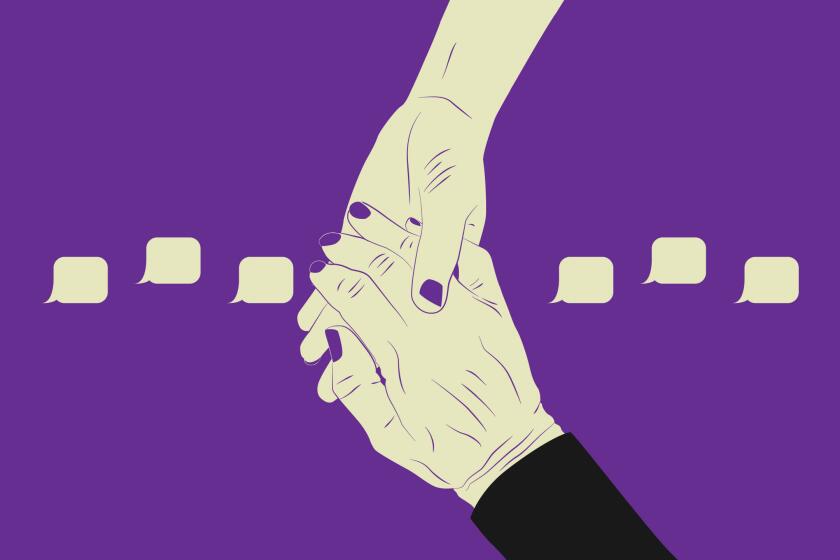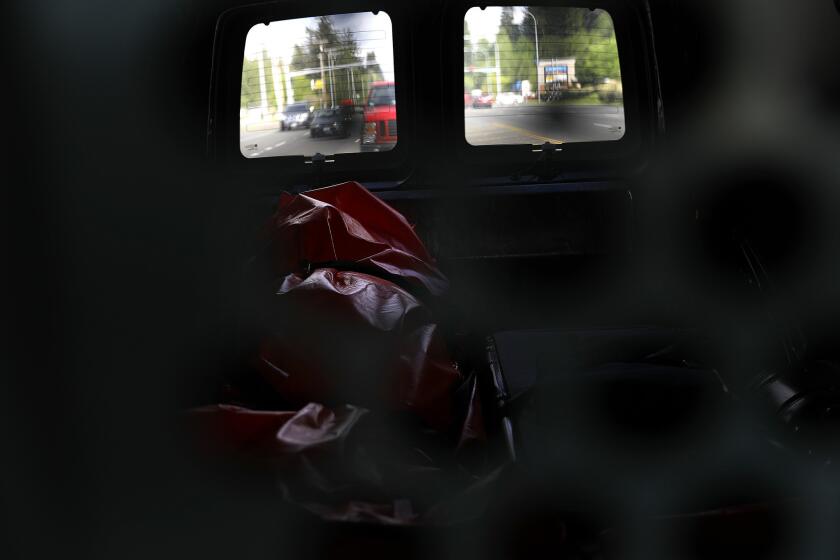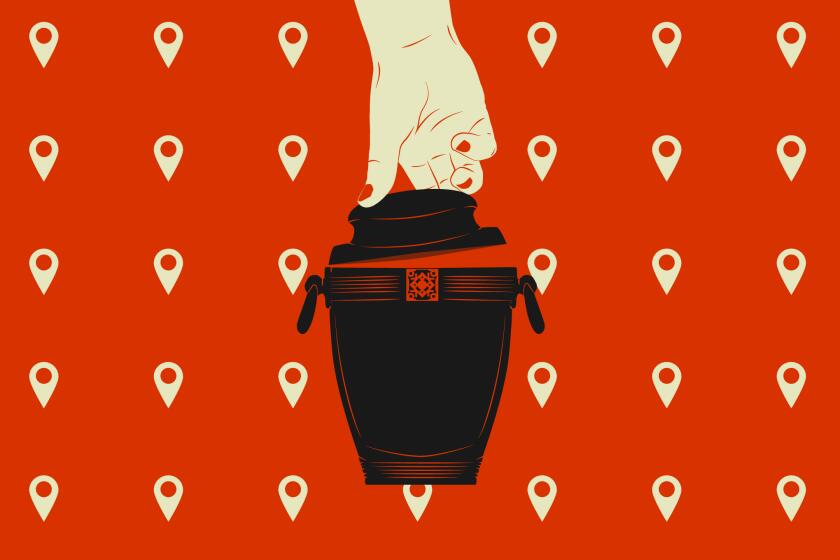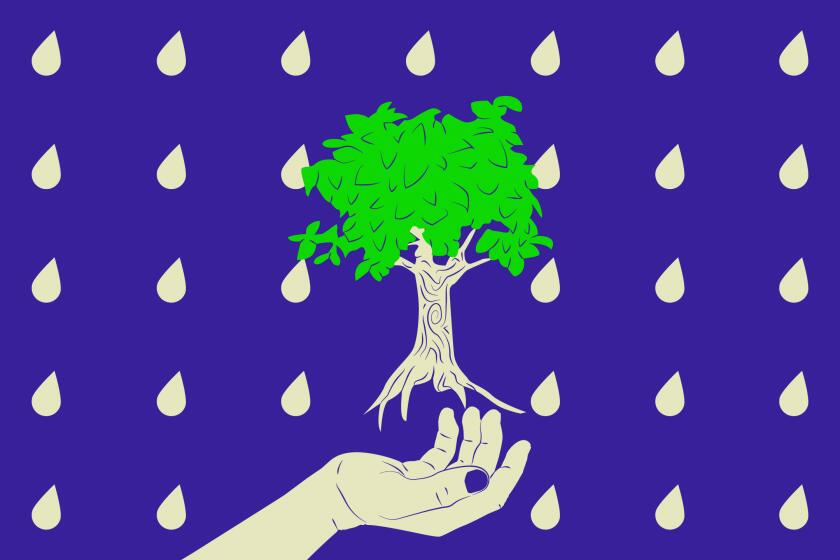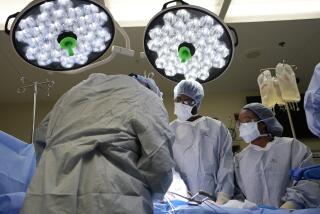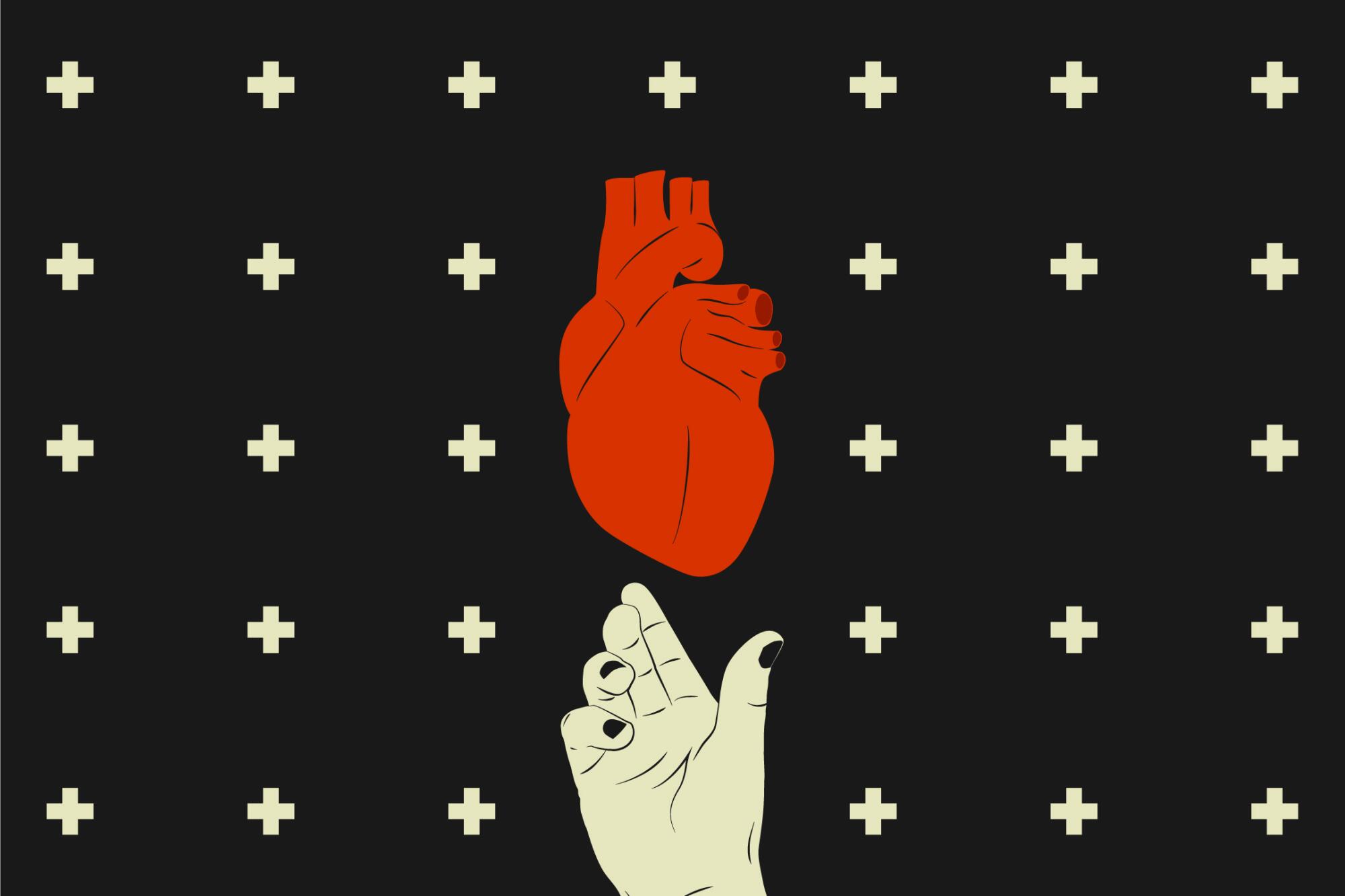
The scene at OneLegacy in Azusa on a recent Friday morning would have been familiar to anyone who’s been in a hospital intensive care unit. Three adults were tucked into hospital beds, still and apparently asleep, with ventilators and other machines of artificial life doing the work that their bodies couldn’t do.
If you didn’t know better, you’d think all the tubes and wires and boxes and screens were designed to save the lives of these patients, but it was too late for that. Instead, the machines were keeping oxygenated blood circulating through soon-to-be-donated organs of three people who had recently been declared brain dead.
OneLegacy, you see, is not a hospital. It’s the country’s largest organ procurement organization. And the kidneys, livers and other organs in those three bodies could save the lives of up to 24 people.
The sad fact of the matter is that there aren’t enough people who end up in a spot like this, their organs being prepped for a new gig in another body. That’s true in part because doctors haven’t figured out yet how to retrieve useful organs from the vast majority of dying patients, and in part because not enough people are willing to give up major body parts after they no longer need them.
You don’t have to die to be an organ donor — you can donate one of your two healthy kidneys and a big chunk of your liver, among other body parts. But even though the total number of living and deceased donors is about 50% higher now than in 2016, a wide gap still remains between the demand for organs and the supply.
Organ donation and transplant centers have controversies of their own to deal with, as does the system as a whole. The Times zoomed in on the challenge facing people on dialysis for kidney failure, a shrinking percentage of whom are making it onto the waiting list for organs. Other problems include a large number of potentially life-saving organs going to waste (including some lost in transit), as well as regional, racial and ethnic disparities in transplants.
According to the U.S. Health Resources and Services Administration, there were more than 100,000 people on the national transplant waiting list in January, with someone added every 10 minutes. The number of transplants performed has grown steadily, but it’s still well short of the number of people waiting for them. Every day, HRSA says, 17 of the people waiting for an organ die.
More than two years have passed since Roland Coleman, a seasoned attorney, started trying to get onto the kidney transplant waitlist.
Here’s an overview of the national system for donations and transplants, what you should know about donating your organs, what some of the problems are, and what the Biden administration is doing to try to solve them.
A short history of organ transplants
The first successful organ transplant on record took place more than 150 years ago, when a Swiss-born physician grafted small pieces of a patient’s skin into a wound in the patient’s arm to speed healing. (Yes, your skin is an organ. In fact, it’s the body’s largest organ.) But transplanting an organ from one person to another is significantly harder because the recipient’s immune system tries to reject the foreign tissue as if it were an invader, not a potential savior.
The breakthroughs started in the 1950s, when a doctor in Boston successfully transplanted the first kidney (from one identical twin to another), followed in the next decade by doctors in Paris making four successful kidney transplants between non-siblings. The next important step was the development of a drug protocol in the 1960s to suppress the immune system, replacing the use of radiation — a technique that rarely held off organ rejection for very long.
The improving techniques boosted interest in transplants, but no system existed to match potential donors and recipients across hospitals and regions. The gap was gradually filled by a new class of middlemen, according to a National Institute of Medicine report: independent regional organ procurement organizations that “identified donors, retrieved organs and found recipients within a reasonable time frame.”
In 1984, the National Organ Transplant Act brought the regional efforts together into a national Organ Procurement and Transplantation Network. Among other duties, the network was tasked with creating a list of individuals who need organs, developing a computerized system for matching them with donors, and helping organ procurement organizations distribute organs “equitably among transplant patients” nationwide.
The network is currently operated by a single contractor: the United Network for Organ Sharing, usually referred to by its initials, UNOS.
Which organs and tissues can be donated?
The Cleveland Clinic cites five organs from a single deceased donor that can potentially be used to save eight lives: the kidneys (one each for two recipients), the liver (two recipients each receiving half), the lungs (one each for two recipients), the heart and the pancreas.
In addition, the donor’s corneas, intestine, middle ear, bones, bone marrow, skin and connective tissue all can be harvested to help improve the lives of ailing or injured patients. Doctors can recover usable bone, skin and other tissues from far more deceased patients than they can recover major organs.
Bone donations are used to replace sections of bone that were lost or removed, as well as to provide a conduit for natural bone regrowth, said Thomas Mone, chief external affairs officer at the OneLegacy Foundation. Researchers are also trying to develop ways to recover bone marrow from a deceased donor to transplant along with the donor’s organs, which could stop the recipient’s immune system from attacking the new organs.
According to Lifebanc, an organ procurement organization in Cleveland, a single donor’s tissue and corneas can help up to 75 people. “Tissue donors save the lives of burn victims through skin grafts, repair faulty heart valves, give sight to the blind, and restore mobility to those who have suffered injuries,” Lifebanc says.
Who can donate?
You might think that the only thing you have to do to become an organ donor is to sign up to be one. But that’s just the easiest part of the process. Whether your organs can help someone else after you die depends on how healthy your organs are and how you met your maker.
Your organs don’t have to be the picture of health to be transplanted. But there are some “comorbidity” conditions that will disqualify them, whether you’re donating while you’re alive (a “living donation”) or not (a “deceased donation”). These include an actively spreading cancer, damage from diabetes or high blood pressure, tumors and other hidden maladies.
A patient’s age is important, but having a liver donated by a 70-year-old is hardly unprecedented, said Dr. Marty Sellers, an organ recovery surgeon at Tennessee Donor Services. Age-related changes in organs can shorten their lifespan in the recipient’s body, he said, but “older livers are still far better than staying on a waiting list.”
Perhaps the biggest limit on organ donation is how quickly organs deteriorate in the body after the heart stops beating. When organs are deprived of oxygenated blood for more than 20 to 30 minutes, they become too damaged to be transplanted, Mone said, adding, “Nobody’s solved that medical riddle yet.” (The clock ticks more slowly for bone and tissue, which can be recovered up to 24 hours after the donor’s time of death, Mone said.)
As a consequence, kidneys, livers and other vital organs are taken only from patients who die in a hospital while on a ventilator. Only 1% of the roughly 2.8 million people who die in the U.S. each year fit into that category, Mone said, and of that group, less than half of the organs available are fit to transplant.
When someone you care for dies unexpectedly, many responsibilities will fall onto your shoulders. Here’s a guide to what they are and how to handle them.
What are the steps?
Each of the 56 not-for-profit organ procurement organizations (OPOs) in the U.S. oversees organ donations in its region. OneLegacy, for example, serves seven Southern California counties with about 20 million residents, collecting donations from 216 hospitals, Mone said.
Federal regulations require hospitals to notify their regional OPO when they have a patient who has died or is facing imminent death. At OneLegacy, staffers use information from the patients’ physicians to identify potential donors, then meet with family members to discuss the patient’s wish to donate (if registered as a donor) or the family’s willingness to donate (if the patient wasn’t registered). As with other surgeries, Mone said, there must be consent to remove the organs.
After organ donation is authorized, the search for a matching recipient on the waitlist begins. After brain death, the OPO conducts more tests on the organs and works to improve their function, trying to get them to the point that the transplant doctors consider viable, Mone said.
A dead body could spend two to three days hooked up to pumps and other medical devices before the organs are ultimately removed, Mone said. OneLegacy is one of four OPOs in California that are set up to maintain bodies after brain death at their own facilities, where they can get a better picture of the health of the organs before removing them. In other cases, including when a donor dies of heart failure instead of brain death, the organs are removed at the donor’s hospital.
The organs are then packaged and hustled to the transplant center where the recipient is waiting. According to Mone and Sellers, properly packaged kidneys ordinarily last for 24 to 36 hours outside the body, while a healthy liver can typically last six to eight hours, and a heart or lungs only three to four hours. Given the short shelf life, Mone said, OPOs typically won’t remove organs other than kidneys if no recipients have been lined up.
Devices and techniques have started emerging to preserve organs longer after their removal, Mone said, but they are “very, very, very early” in their development.
Talking about burial arrangements or end-of-life care isn’t the easiest conversation to have with family members. But it can be done with respect, humility and love.
Who can get a donated organ?
The organs gathered by OPOs go only to people on the waiting list. And the only way to get on the list is to be referred to a transplant center, where doctors will test you to determine whether you’re a suitable candidate.
According to UNOS, each transplant center has its own criteria for suitability, so it pays to check those out in advance. To find a center near you, consult the Scientific Registry of Transplant Recipients.
When an OPO knows an organ is coming in, it checks the UNOS computer system for the best match on the waiting list. If your name comes up as the top match, the OPO confirms with your physician that the donor’s blood type, tissue antigens and other details are compatible with yours. Historically, Mone said, two other key factors were how close you were to a transplant center and how long you’d been waiting for a new organ. But the considerations have evolved over time, he said; what matters most now is how close you are to dying and how long you’re likely to survive after the operation.
Still, Mone said, most organs (and especially kidneys) are transplanted in the same region where they are donated. That’s why experts suggest getting on the waiting list in more than one region. To do so, you’ll have be evaluated and approved by one or more additional transplant centers.
What are the problems in the system?
Medical experts say the biggest problem is the growing gulf between the number of donations and the demand for replacement kidneys, livers and other major organs.
E’Tiffany Jones, communications manager for OneLegacy, said there’s a prevalent myth that deters people from registering as an organ donor: “If you have a pink dot, the hospital will not save you.” In truth, Jones and Mone said, hospitals try to save every patient they can, and OPOs like OneLegacy have no role in those decisions. Besides, Mone said, if a hospital doesn’t try to save a patient, the organs are likely to be unfit to donate.
White and Latino patients and their survivors authorize donations at a significantly higher rate than Black or Asian patients and survivors, a situation that Mone said reflects distrust of the system and cultural opposition to organ donation. Although the organ donation authorization rate in OneLegacy’s region was 87% for white and 73% for Latino patients from 2017 to 2020, it was only 58% for potential Black and Asian donors, the organization says. The rates for the U.S. as a whole follow a similar pattern.
There’s also a racial disparity on the receiving end of donated organs.
According to OneLegacy’s statistics for 2021, nonwhite people in its region receive a share of the transplants that’s proportionate to their numbers, but not to their need. Making matters worse, Mone said, Black Americans suffer from kidney failure at three times the rate of white Americans, yet they aren’t getting on the waiting list for transplants at that rate.
Four years ago, The Times chronicled several cases in which OneLegacy and other OPOs were allowed to harvest organs and tissue before a coroner could conduct an autopsy and determine a cause of death. In some of the cases, prosecutors couldn’t file murder charges without the cause of death determination. At the request of the L.A. County Board of Supervisors, the county’s chief medical examiner-coroner investigated and found that organ procurement before autopsies “does not have a significant effect” on his office’s ability to determine the cause of death. The county continues to allow OneLegacy to take bodies before autopsies.
Companies that harvest human organs, bones and other parts have moved into government morgues across the country to gain access to more bodies.
How to register to be a donor
Years ago, you’d express your interest in donating your organs by putting a pink dot on your driver’s license. Those dots have since been augmented by an electronic registry, which you can sign up for through your state’s site or RegisterMe.org. You also can register by visiting your local Department of Motor Vehicles office or, if you have an Apple iPhone, through the Health app.
To register, you’ll need to supply your name, gender, birth date, street address, email address and place of birth. If you’d prefer to mail in your registration in California, you can download the form from the state registry’s website, fill it out and return it to Donate Life California, 3940 Industrial Blvd., West Sacramento, CA 95691.
Being an organ donor is not an all-or-nothing choice — you’ll also have the opportunity to decide which organs and tissues can be taken from your body after death. You can also restrict your tissue donations to nonprofit organizations, confine your tissue donations to the U.S., bar your body parts from being used in medical research, and prevent your skin from being used in anything other than life-saving or reconstructive purposes.
By creating an account with the state donor registry, you’ll also be able to add or remove restrictions over time. But only you can make those changes; according to Donate Life California, no one can override your choices after you die.
States keep registries just of people who want to be donors; there’s no “Do not harvest my organs” list for those who don’t. If you do not want your organs to be taken after you die, Mone said, you can make this clear in an advance healthcare directive — a document that outlines how aggressively you want doctors to treat you near the end of your life.
L.A. is a complicated place to live. Does it have to be such a complicated place to scatter ashes after someone dies?
How much does a recipient pay?
The system is designed to charge the person who needs a transplant all the costs associated with removing, maintaining and transplanting the donated organ. How much you’d pay for a new organ depends on the deductibles, out-of-pocket costs and exclusions in your insurance policy; the same is true for the costly drugs that fight rejection.
Examining U.S. data from 2020, analysts at Milliman, an insurance consultancy, estimated that the average medical bill for transplants was $442,500 for a kidney, $878,400 for a liver, $1.2 million for an intestine and $1.7 million for a heart. The amounts paid by insurers were probably lower, Milliman said, because of the lower rates they negotiated.
Can organs be sold?
Not legally, at least not in the vast majority of countries (Iran is one notable exception). In the U.S., federal law prohibits the sale of body parts, as do state versions of the Uniform Anatomical Gift Act.
“Selling body parts has a long and sordid history,” Mone said. While some economists argue that paying donors would increase the supply of organs and shorten the waiting list, he said, nations have banned it because they worry that “paying for organs would lead to poor people donating to save rich patients.” And that’s been the experience in Iran, where the bulk of the donated organs have come from poor tribespeople, not the rich or the well-educated, Mone said.
People are choosing eco-friendly and creative options for their final resting places, including the bottom of the ocean and miles and miles into outer space.
What changes are coming to the transplant system?
The Biden administration announced plans in March to modernize the Organ Procurement and Transplantation Network, including more than doubling the government’s investment in the system. The most visible result is a new online dashboard showing the annual tally of transplants performed state by state, the number of people on waiting lists for each major organ, and other performance data.
One of the main features of the effort is the possible end of UNOS’s monopoly on the key aspects of the network. Going forward, the administration said, it will break the system’s operations, governance and technology into separate contracts that will be held, potentially, by different companies.
Barry Massa, president of the Assn. of Organ Procurement Assns. and executive director of the LifeCenter Organ Donor Network in Cincinnati, said the association welcomes the administration’s effort, and more broadly supports the recommendations the National Research Council made last year to improve equity, transparency and efficiency in the system. “Anything that can improve the system, we are supportive of,” Massa said.
About The Times Utility Journalism Team
This article is from The Times’ Utility Journalism Team. Our mission is to be essential to the lives of Southern Californians by publishing information that solves problems, answers questions and helps with decision making. We serve audiences in and around Los Angeles — including current Times subscribers and diverse communities that haven’t historically had their needs met by our coverage.
How can we be useful to you and your community? Email utility (at) latimes.com or one of our journalists: Jon Healey, Ada Tseng, Jessica Roy and Karen Garcia.
More to Read
Sign up for Essential California
The most important California stories and recommendations in your inbox every morning.
You may occasionally receive promotional content from the Los Angeles Times.
